In a world that often seems consumed by competition and individual success, teaching kids kindness to children has become more important than ever before. While academic achievements and career accomplishments are undoubtedly valuable, cultivating a compassionate and empathetic mindset in young individuals is equally essential for their personal growth and the betterment of society as a whole.
Kindness, at its core, encompasses the act of showing understanding, consideration, and respect toward others. By instilling this virtue in children from an early age, we empower them to develop strong interpersonal skills, build healthy relationships, and contribute positively to their communities. Teaching kids kindness goes beyond simply encouraging polite behavior; it involves fostering an authentic sense of empathy, compassion, and altruism within children’s hearts.
When children learn to be kind, they acquire a set of crucial life skills that can positively impact their mental, emotional, and social well-being. Research has shown that individuals who exhibit kindness and empathy tend to experience greater happiness, reduced stress levels, and improved overall mental health.
By teaching kids kindness early on, we empower them to become agents of positive change, capable of promoting equality, inclusivity, and justice. In a world that faces numerous social, environmental, and humanitarian challenges, nurturing a generation of kind-hearted individuals is crucial for creating a more compassionate and sustainable future.
1. Kindness Jar
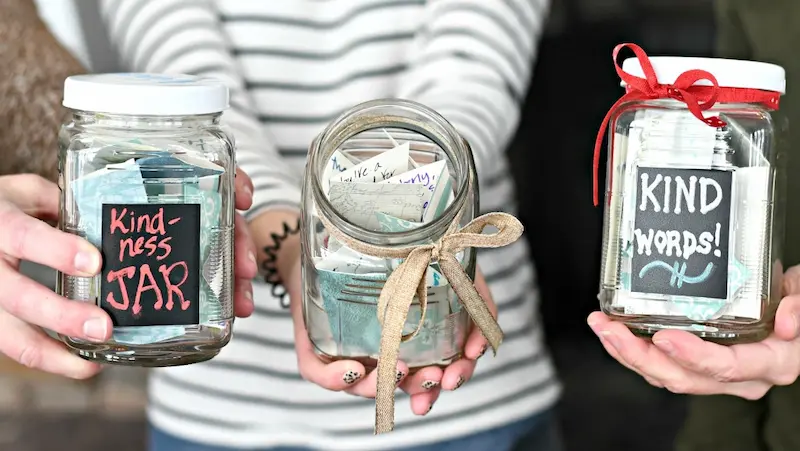
Explanation of the Activity:
The Kindness Jar is a tangible representation of kindness and a reservoir of positivity. It involves collecting and recording acts of kindness in the form of written notes or small tokens, which are then placed into a jar. Each act of kindness serves as a reminder of the goodness in the world and can be drawn upon during challenging times.
Creating a Kindness Jar:
Creating a Kindness Jar is a straightforward and enjoyable process. Here’s how you can get started:
Choose a jar or container: Select a jar or container that resonates with you. It can be a mason jar, a decorative box, or any other container that you find appealing. Make sure it is large enough to hold numerous notes or tokens.
Decorate the jar: Personalize your Kindness Jar by decorating it. You can use ribbons, stickers, paints, or any other materials that reflect your unique style and creativity. This step can also involve getting your family or friends involved, making it a collaborative effort.
Prepare kindness cards or tokens: Use small pieces of paper, index cards, or even colorful sticky notes to create kindness cards. Alternatively, you can use small tokens such as stones, beads, or other symbolic items to represent acts of kindness.
Write down acts of kindness: Encourage yourself and others to write down acts of kindness they have witnessed, received, or performed themselves. These acts can range from simple gestures like holding the door for someone or offering a compliment to more significant acts like volunteering or helping a stranger in need.
Fill the jar with kindness: As the acts of kindness accumulate, place the kindness cards or tokens into the jar. Watch as the jar slowly fills up, becoming a beautiful visual representation of the collective kindness shared.
Suggestions for Acts of Kindness to Fill the Jar:
The Kindness Jar can be filled with a wide variety of acts, both big and small. Here are some suggestions to get you started:
1. Compliment someone and make their day brighter.
2. Help an elderly neighbor with their groceries or household chores.
3. Donate unused clothes, books, or toys to those in need.
4. Write a heartfelt note or send a caring message to a friend or loved one.
5. Pay for the coffee or meal of the person behind you in line.
6. Volunteer your time at a local charity or organization.
7. Offer assistance to someone struggling with a task.
8. Practice active listening and offer support to someone who needs to talk.
9. Hold the door open for others or let someone go ahead of you in line.
10. Perform random acts of kindness anonymously, such as leaving uplifting notes in public places.
2. Kindness Cards
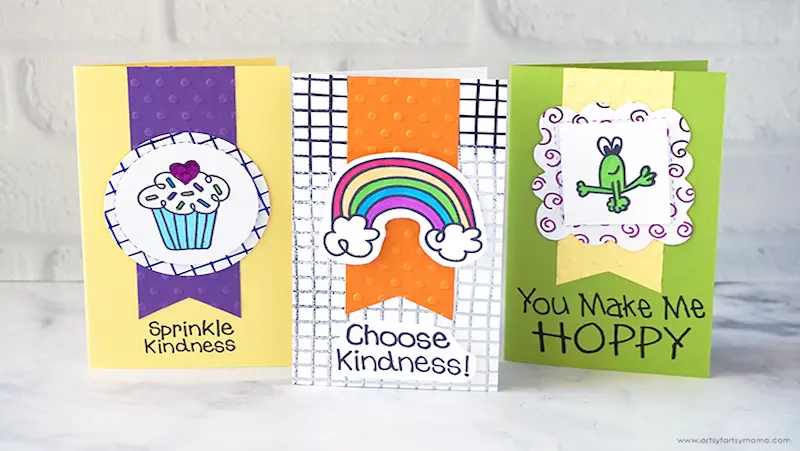
In a world that often seems to be moving at lightning speed, with people consumed by their own busy lives and daily struggles, it’s easy to forget the profound impact a simple act of kindness can have on someone’s day.
Kindness cards offer a beautiful way to spread love and compassion, reminding us that small gestures can make a big difference. In this blog, we’ll explore what kindness cards are, how to create and distribute them and provide some inspiring ideas for acts of kindness to write on these cards.
Instructions for creating and distributing kindness cards:
Materials:
1. To start, gather the following materials:
2. Blank cards or cardstock paper
3. Markers, colored pencils, or pens
4. Stickers, stamps, or other decorative items (optional)
Designing the cards:
Get creative and design your kindness cards! You can make them as simple or as elaborate as you like. Consider using bright and uplifting colors, inspiring quotes, or charming illustrations. Remember, the goal is to bring joy and positivity to the recipients.
Writing the message:
On the front of the card, write a heartfelt message like “A Random Act of Kindness” or “You are Loved.” On the inside, leave space for you or others to write a personalized note or act of kindness.
Ideas for acts of kindness to write on the cards:
Compliments: Write uplifting and genuine compliments like, “You have a contagious smile,” or “Your kindness brightens the world.”
Encouragement: Inspire someone by leaving messages such as, “Belief in yourself; you can accomplish anything,” or “You are stronger than you think.”
Gratitude: Express appreciation by acknowledging specific acts of kindness or simply saying, “Thank you for being you.”
Support: Provide words of comfort and support during challenging times. For example, “Remember, you’re not alone. Reach out if you need a listening ear.”
Acts of Service: Offer acts of service, such as “Let me buy your coffee today,” or “I’ll help you with that project you’ve been struggling with.”
Spread positivity: Share positive affirmations like, “Today is a beautiful day to make a difference,” or “You are capable of greatness.”
Inspirational quotes: Write down motivational quotes that resonate with you, uplifting others with powerful words of wisdom.
Distributing kindness cards:
Random Acts: Leave kindness cards in public spaces, such as cafes, libraries, or parks, for strangers to discover and brighten their day.
Workplace: Share kindness cards with colleagues, leaving them on desks or in communal areas as a thoughtful surprise.
School and Community: Distribute kindness cards to teachers, classmates, or community members, spreading positivity and building connections.
Family and Friends: Give kindness cards to your loved ones on special occasions or just to remind them of how much they mean to you.
Remember, the goal of kindness cards is to make others feel seen, appreciated, and loved. Even a small act of kindness can have a ripple effect, inspiring others to pay it forward and create a more compassionate world.
3. Random Acts of Kindness Challenge

Description of the Random Acts of Kindness Challenge:
The Random Acts of Kindness Challenge is a delightful initiative that encourages individuals, families, schools, and communities to actively engage in acts of kindness. The challenge is simple: commit to performing a specific number of random acts of kindness within a given timeframe, such as a week, a month, or even a year.
This challenge aims to promote the values of kindness, empathy, and compassion in our daily lives. It encourages us to go beyond our comfort zones and extend a helping hand to those around us, fostering a sense of connection and empathy. The acts can be as small as smiling at a stranger or as impactful as organizing a community service project. Every act, regardless of its scale, has the potential to create a positive impact. learn about banking games for kids also.
List of Suggested Kind Acts for Children to Complete:
1. Compliment someone and make their day brighter.
2. Help a classmate or a friend with their schoolwork.
3. Hold the door open for someone.
4. Share your lunch or snacks with a peer who forgot theirs.
5. Write a thank-you note to a teacher or a family member.
6. Help with household chores without being asked.
7. Offer to carry groceries for an elderly neighbor.
8. Donate toys or clothes to a local charity.
9. Plant flowers or trees in your community.
10. Volunteer at a local animal shelter or food bank.
11. Create uplifting artwork or cards for hospital patients.
12. Offer to babysit for a busy parent.
13. Pick up litter in a park or on the street.
14. Bake cookies for a neighbor or local firefighters.
15. Offer a listening ear and support to someone who is going through a tough time.
Tracking Progress and Celebrating Achievements:
To make the Random Acts of Kindness Challenge more engaging and rewarding, it’s helpful to track progress and celebrate achievements along the way. Here are some ideas to inspire and motivate participants:
Kindness Jar: Create a jar or a box where participants can write down their completed acts of teaching kids kindness on small pieces of paper. At the end of the challenge, gather together and read aloud the acts of kindness shared, celebrating everyone’s contributions.
Kindness Chart: Design a chart where participants can mark off completed acts of kindness. As each act is accomplished, they can add a sticker or a checkmark. This visual representation of progress can be motivating and encourage participants to keep going.
Kindness Wall: Create a designated wall or bulletin board to showcase acts of kindness. Participants can write or draw their acts on colorful sticky notes or index cards and display them for everyone to see. This serves as a visual reminder of the positive impact being made.
Certificates of Kindness: At the end of the challenge, provide participants with certificates of kindness, acknowledging their commitment and effort. This simple gesture can boost their self-esteem and reinforce the value of kindness.
Share Stories: Encourage participants to share their experiences and stories of kindness. This can be done through a shared blog, social media, or in-person gatherings. By sharing these stories, participants inspire others to join the challenge and create a domino effect of kindness.

4. Gratitude Jar
Exploring the Connection between Kindness and Gratitude:
Kindness and gratitude share a beautiful symbiotic relationship. When we extend acts of teaching kids kindness to others, we not only uplift their spirits but also create a positive ripple effect in our own lives. The act of being kind triggers a sense of empathy and compassion within us, opening the door to gratitude.
Similarly, gratitude enhances our ability to recognize and appreciate acts of kindness, reinforcing the cycle of positive emotions. By actively acknowledging and expressing gratitude for acts of kindness, we can deepen our connections with others and experience a greater sense of fulfillment.
Creating a Gratitude Jar and Gratitude Notes:
The Gratitude Jar is a tangible and visual reminder to regularly practice gratitude. Follow these simple steps to create your own gratitude jar:
Find a suitable container: Choose a jar, box, or any other container that resonates with you. It could be a recycled glass jar, a decorative box, or even a specially designated notebook.
Decorate your jar: Personalize your gratitude jar by adding decorative elements such as ribbons, stickers, or labels. Get creative and make it unique to your own style and preferences.
Gather gratitude notes: Cut small pieces of paper or use sticky notes to create gratitude notes. These will be used to jot down moments of kindness or things you’re grateful for.
Start expressing gratitude: Every day, take a few moments to reflect on acts of kindness you’ve experienced or things you appreciate. Write them down on the gratitude notes and place them in the jar.
Read and reflect: Whenever you need a boost of positivity, open the gratitude jar and read through the notes. Allow yourself to fully experience gratitude and let it uplift your mood.
Encouraging Children to Express Gratitude for Acts of Kindness Received:
Teaching kids kindness about gratitude from an early age sets the foundation for a positive mindset and emotional well-being. Here are some ways to encourage children to express gratitude for acts of kindness received:
Lead by example: Children learn best by observing the behavior of others. Show gratitude openly and frequently for acts of kindness you receive, and they will follow suit.
Storytelling and role-playing: Engage children in storytelling or role-playing activities that highlight acts of kindness and gratitude. Encourage them to express appreciation for the kindness they witness in everyday situations.
Gratitude jar as a family activity: Involve your children in creating a gratitude jar for the whole family. Encourage them to contribute their own gratitude notes, fostering a culture of appreciation within the household.
Gratitude journaling: Encourage older children to keep a gratitude journal, where they can write down daily reflections on acts of kindness or things they are grateful for. This practice helps them develop a habit of acknowledging and expressing gratitude.
Thank-you notes and gestures: Teach children the importance of saying thank you and expressing gratitude through handwritten thank-you notes or small acts of kindness. Encourage them to express appreciation for acts of kindness they receive from friends, teachers, or family members.
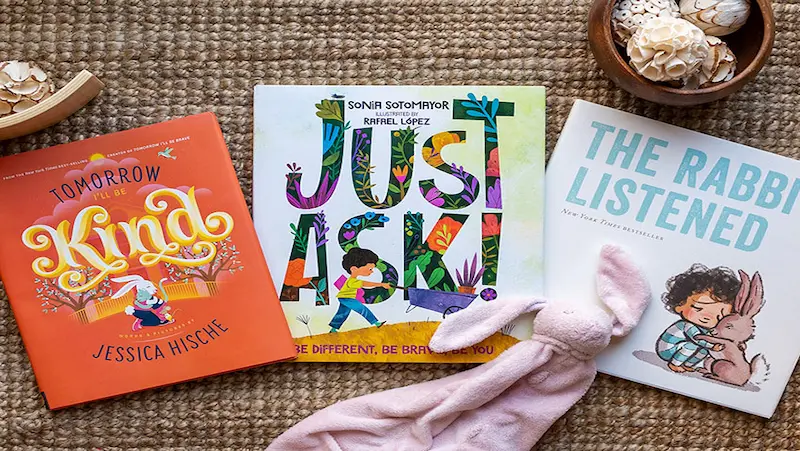
5. Storytime with Kindness Themes
Encouraging empathy and compassion from a young age not only helps children develop strong interpersonal skills but also contributes to building a kinder and more inclusive society. One powerful way to instill these values is through storytime with kindness themes.
By selecting books that promote acts of kindness, organizing engaging read-aloud sessions, and incorporating role-playing and creative activities, we can inspire children to embrace kindness as an integral part of their lives.
Suggesting books with kindness themes for children:
Choosing the right books is crucial when it comes to teaching kids kindness. Here are a few heartwarming and meaningful books that can help children understand the importance of kindness:
“The Giving Tree” by Shel Silverstein: This timeless classic explores the unconditional love and selflessness of a tree towards a young boy throughout his life. It beautifully illustrates the value of giving and the joy that comes from acts of kindness.
“Ordinary Mary’s Extraordinary Deed” by Emily Pearson: This book follows the story of Mary, an ordinary girl who starts a chain reaction of kindness by giving blueberries to her neighbor. It emphasizes how a small act of kindness can have a profound impact on others.
“Each Kindness” by Jacqueline Woodson: This poignant tale emphasizes the significance of kindness and how every act, big or small, matters. It encourages children to be mindful of their actions and the ripple effect they can create.
“Those Shoes” by Maribeth Boelts: This story addresses the importance of empathy and selflessness when a young boy learns about the difference between needs and wants. It teaches children to prioritize the needs of others over their own desires.
Read-aloud sessions with discussions on kindness:
Conducting read-aloud sessions provides an excellent opportunity to engage children and have meaningful discussions about kindness. Here are some tips to make these sessions interactive and impactful:
1. Before reading the book, ask children what they think kindness means and why it is important. Encourage them to share their experiences of kindness or instances where they have witnessed kindness.
2. As you read the book, pause at key moments to ask open-ended questions. For example, “How do you think the character felt when they received an act of kindness?” or “What would you have done in this situation?”
3. After reading the story, facilitate a group discussion about the moral of the story and how the characters demonstrated kindness. Encourage children to share their thoughts and relate the story to their own lives.
Engaging children in role-playing or creative activities related to the stories:
To further reinforce the messages of kindness, incorporating role-playing and creative activities can be incredibly effective. Participating in activities for kids that involve spreading messages of kindness can help kids develop a strong sense of empathy and compassion from a young age. Here are a few ideas to engage children:
Role-playing: Encourage children to act out scenes from the story where characters display acts of kindness. This allows them to step into someone else’s shoes and understand the impact of their actions.
Artistic expression: Provide art supplies and ask children to create illustrations or collages depicting acts of kindness. This allows them to express their understanding of teaching kids kindness visually.
Kindness jar: Have children decorate a jar and encourage them to write or draw acts of kindness they perform each day on small pieces of paper. At the end of the week, discuss the acts of kindness and celebrate their efforts.
6. Community Service Project
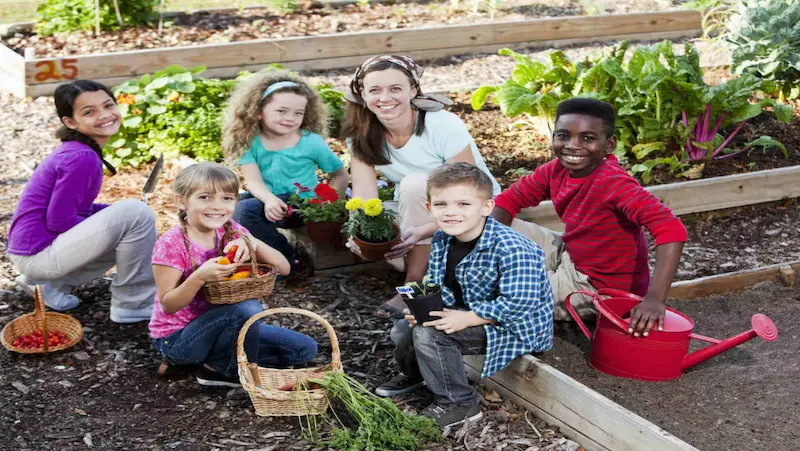
Planning a Small-Scale Community Service Project:
When embarking on a community service project, it is essential to start with a well-thought-out plan. Here are some key steps to consider:
a. Identify a need: Assess your community to identify areas that require attention. It could be environmental conservation, assisting the elderly, or supporting local schools or shelters.
b. Set goals: Clearly define the objectives you want to achieve through your project. Establish specific, measurable, achievable, relevant, and time-bound (SMART) goals that align with the identified need.
c. Research and gather resources: Conduct research to understand existing resources and potential partnerships that can aid your project. Reach out to local organizations, businesses, and community leaders who may be interested in supporting your cause.
d. Create a timeline: Develop a timeline with specific deadlines for each phase of the project, including planning, implementation, and evaluation. This will help you stay organized and ensure the project progresses smoothly.
e. Form a team: Recruit volunteers from your community, including children and adults, who share a passion for making a difference. Assign specific roles and responsibilities to each team member, considering their strengths and interests.
Examples of Age-Appropriate Service Activities:
Service activities can be tailored to suit different age groups, ensuring that children feel engaged and motivated. Here are some examples of age-appropriate service activities:
a. Young children (ages 4-7):
1. Cleaning up local parks or playgrounds
2. Planting trees or creating a community garden
3. Collecting and donating toys to underprivileged children
b. Pre-teens (ages 8-12):
1. Organizing a food or clothing drive for a local shelter
2. Creating care packages for the elderly or soldiers overseas
3. Assisting in animal shelters by walking dogs or socializing with cats
c. Teenagers (ages 13-17):
1. Volunteering at a soup kitchen or homeless shelter
2. Mentoring younger children through tutoring or after-school programs
3. Participating in environmental cleanup initiatives
Involving Children in Decision-Making and Execution:
Empowering children to be actively involved in the decision-making and execution of community service projects is crucial for their personal growth and development. Here’s why it matters:
a. Ownership and responsibility: By involving children in the planning process, they develop a sense of ownership and responsibility towards the project and the community it serves. This instills a lifelong commitment to making a positive impact.
b. Leadership and teamwork: Allowing children to make decisions and take on leadership roles encourages the development of essential leadership and teamwork skills. They learn to communicate effectively, delegate tasks, and collaborate with others toward a common goal.
c. Building empathy and understanding: When children actively participate in service projects, they witness firsthand the challenges faced by others in their community. This experience fosters empathy, compassion, and a broader understanding of social issues. Teaching good manners for kids goes hand in hand with building empathy and understanding, fostering well-rounded individuals.
d. Strengthening community bonds: Involving children in community service projects creates intergenerational connections, fostering stronger relationships between different age groups within the community. This promotes a sense of unity and solidarity.
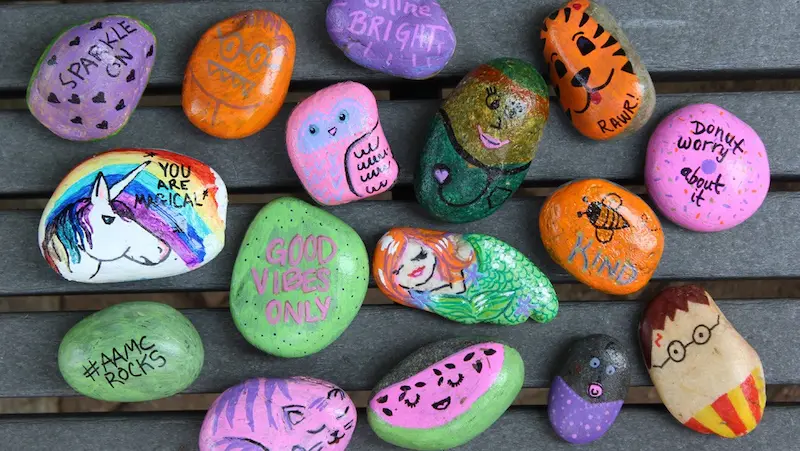
7. Kindness Rocks
Introducing the Concept of Kindness Rocks:
The Kindness Rocks movement began with Megan Murphy in Cape Cod, Massachusetts, in 2015. She initiated the idea of painting rocks with inspirational messages and leaving them in public spaces for others to find. The purpose of this movement is to promote teaching kids kindness, connection, and a sense of community. By stumbling upon these beautifully painted rocks, people are reminded that there is goodness in the world and that they are not alone in their struggles. Engaging in art projects for kids, like creating kindness rocks, promotes creativity and spreads positive messages in a fun and meaningful way.
Instructions for Painting and Placing Kindness Rocks:
Painting and placing kindness rocks is a creative and fulfilling activity in that anyone can participate in. Combining mindfulness meditation for kids with the activity of placing kindness rocks can create a harmonious and thoughtful experience. Here’s a step-by-step guide to getting you started:
Gather your materials: You’ll need smooth rocks, acrylic paints, paintbrushes, and a waterproof sealant (optional).
Choose your message or design: Decide what message or image you want to convey on your rock. It could be an inspirational quote, a simple word like “love” or “hope,” or a colorful design that brings joy.
Paint your rock: Use acrylic paints to bring your chosen message or design to life. Let your creativity flow and have fun with different colors and patterns. Remember, the goal is to spread positivity, so choose vibrant and uplifting colors.
Add final touches: Once the paint has dried, you can enhance your design by outlining it with a permanent marker or adding details with a fine-tip brush.
Seal the rock (optional): To protect your artwork from the elements, consider applying a waterproof sealant. This will ensure that your kindness rock stays vibrant and intact for a longer period.
Find a location: Choose a public space in your community where people are likely to come across your rock. Parks, gardens, walking trails, or even near local businesses are excellent options. Just make sure to follow any guidelines or rules regarding rock placement in your area.
Place your kindness rock: Find a spot where your rock will be easily visible and make someone’s day brighter. You can lay it in plain sight or tuck it away slightly, leaving a pleasant surprise for the person who discovers it.
Spreading Positivity and Kindness Through Rock Sharing:
The beauty of Kindness Rocks lies in the act of sharing and connecting with others. When someone finds a painted rock, they are greeted with an unexpected gift that brightens their day. The uplifting messages or designs on these rocks have the power to inspire, encourage, or simply bring a smile to someone’s face. Furthermore, the act of searching for and discovering Kindness Rocks can spark conversations, foster a sense of community, and remind us all of the importance of teaching kids kindness.
The ripple effect of this movement is awe-inspiring. A single act of painting and placing a rock can lead to a chain reaction of teaching kids kindness. The person who finds a rock may choose to keep it as a personal memento or rehide it for someone else to discover. They might also be inspired to create their own teaching kids kindness rocks and contribute to the movement. Through this process, connections are formed, strangers become friends, and positivity is spread far and wide.
Also, introducing growth mindset books for kids can nurture positive thinking and a belief in their ability to overcome challenges.
Conclusion
In conclusion, practicing teaching kids kindness in our daily lives is an essential aspect of creating a positive and harmonious world. It is a virtue that holds the power to transform lives, mend broken relationships, and foster a sense of unity among individuals. The impact of even the smallest acts of teaching kids kindness should not be underestimated, as they have the potential to ripple through society and inspire others to follow suit. Practicing mindfulness exercises for kids can cultivate a sense of kindness and compassion from an early age.
Throughout history, countless examples have shown us the profound influence of kindness. From the heroic stories of selflessness to the simple acts of compassion and empathy, kindness has the ability to transcend barriers of culture, language, and background. It has the capacity to touch hearts, heal wounds, and ignite hope in the midst of despair.
Practicing kindness in our daily lives not only benefits those on the receiving end but also brings immense satisfaction and fulfillment to ourselves. It allows us to connect with our innate humanity and reaffirm our interconnectedness with others. Kindness nurtures a sense of belonging and reminds us that we are all part of a larger, shared existence.
Let us remember that teaching kids kindness is not limited to grand gestures or extraordinary acts. It can be as simple as a smile, a listening ear, or a small act of service. By incorporating kindness into our daily routines, we contribute to a more compassionate and inclusive world, one interaction at a time.
So, let us continue to practice teaching kids kindness in our daily lives. Let us be mindful of the opportunities that arise each day to make a positive impact on others. By cultivating kindness, we can create a ripple effect that spreads throughout our communities, inspiring others to follow our example. Together, we can build a world where empathy, understanding, and compassion thrive, fostering a brighter future for all. Learn about financial education for kids also.
Exploring the diverse educational offerings on BrightChamps opens up exciting opportunities for children to learn and thrive in a supportive and dynamic online environment.
Exploring the BrightChamps blog page provides valuable insights and educational resources for learners of all ages.
Frequently Asked Questions
A1. Some fun activities to teach kids about kindness include role-playing scenarios, creating kindness cards or notes, and engaging in random acts of kindness.
A2. Encourage your child to be kind through interactive activities such as volunteering, participating in community service projects, or organizing a kindness-themed scavenger hunt.
A3. Yes, there are games like “Kindness Bingo,” “The Kindness Jar,” and “Acts of Kindness Relay” that focus specifically on teaching kindness to children.
A4. Engage kids in acts of kindness they will enjoy by organizing a toy or book drive, setting up a lemonade stand for charity, or planning a “Kindness Olympics” with various challenges.
A5. Age-appropriate activities promoting empathy and kindness include storytelling, creating kindness-themed artwork, and participating in sharing circles or discussions about emotions and empathy.
A6. Incorporate kindness into everyday routines or family activities by practicing gratitude, assigning daily acts of kindness, and role-modeling kind behavior within the family.
A7. Art or craft projects like creating kindness collages, decorating kindness rocks, or making friendship bracelets can help teach kids the importance of kindness.
A8. Storytelling and books play a significant role in teaching children about kindness and compassion by conveying moral lessons, fostering empathy, and inspiring positive behavior.
A9. Parents or teachers can make teaching kindness fun and interactive for kids by using puppet shows, interactive videos, gamified apps, or organizing kindness-themed competitions.
A10. Group activities or projects like organizing a community garden, creating care packages for those in need, or planning a kindness-themed school event can encourage children to work together and practice kindness.

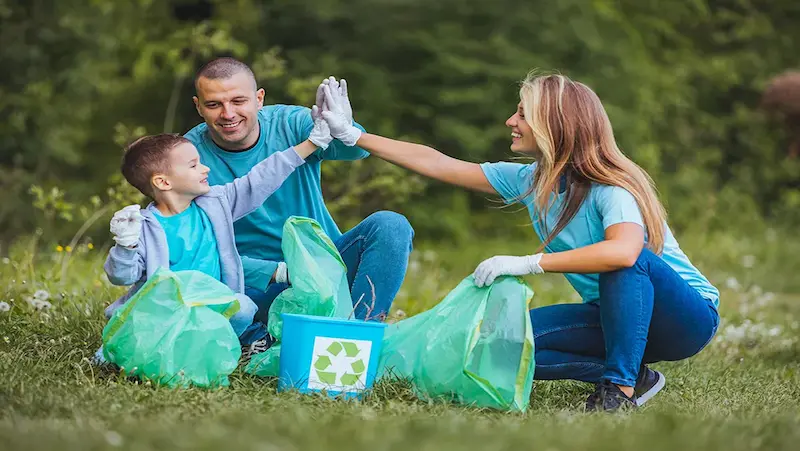

 We are an army of educators and passionate learners from BrightChamps family, committed to providing free learning resources to kids, parents & students.
We are an army of educators and passionate learners from BrightChamps family, committed to providing free learning resources to kids, parents & students.














